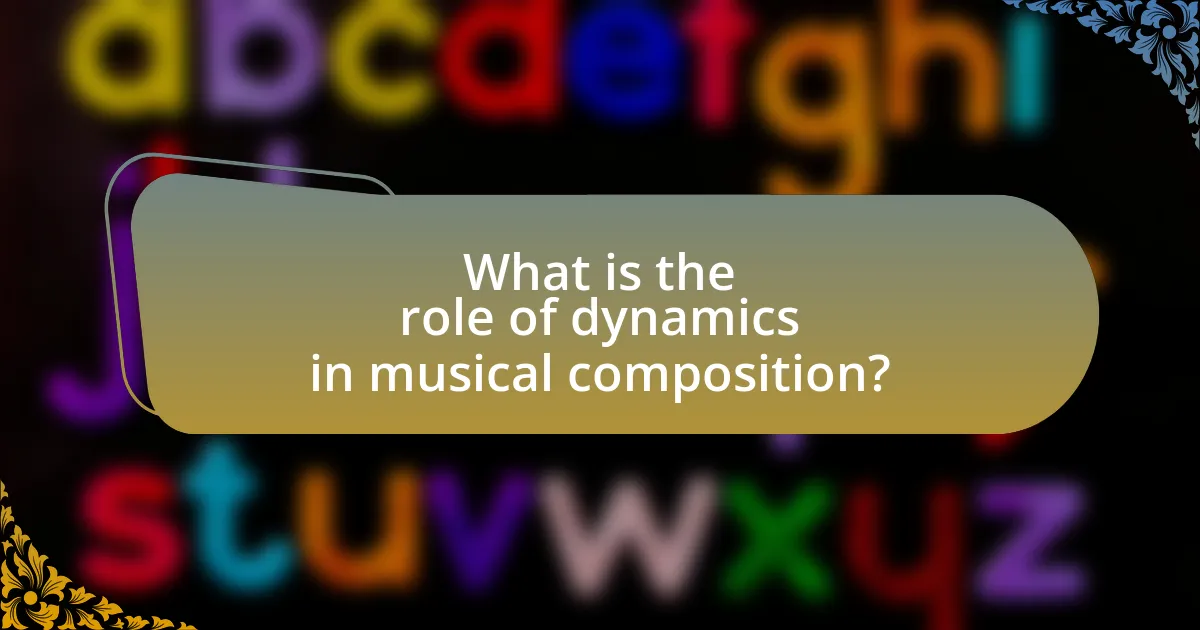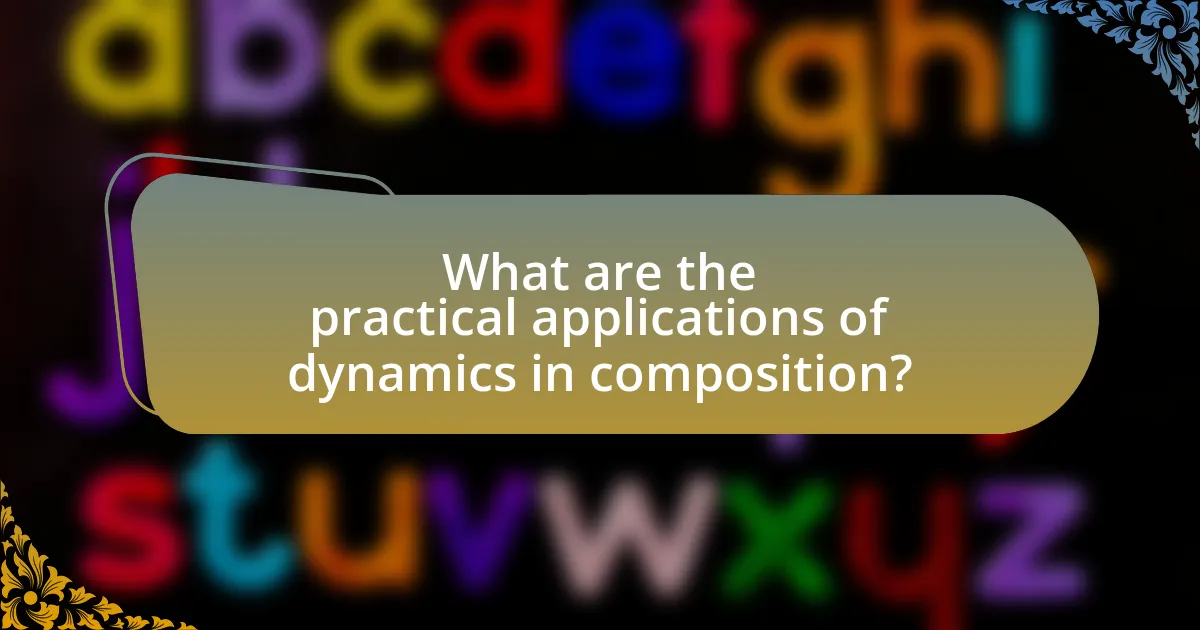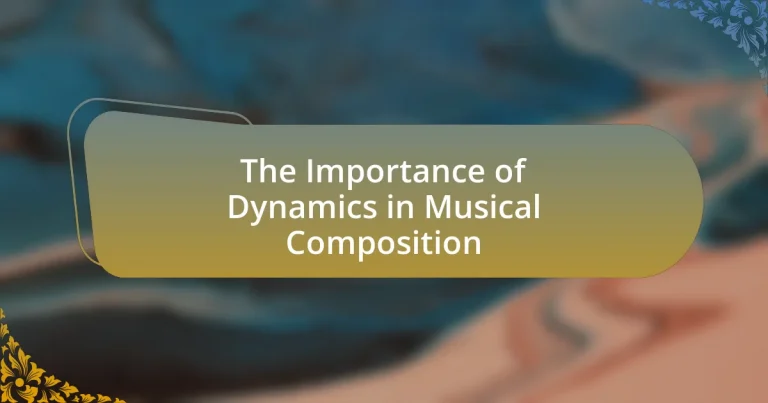The article focuses on the significance of dynamics in musical composition, emphasizing how variations in loudness and intensity enhance emotional expression and structural integrity within a piece. It explores the influence of dynamics on listener engagement, emotional responses, and the overall impact of music, detailing various dynamic markings and their applications. Additionally, the article discusses techniques for composers to effectively manipulate dynamics, the interaction of dynamics with other musical elements such as melody, harmony, and rhythm, and practical tips for mastering dynamic expression in compositions.

What is the role of dynamics in musical composition?
Dynamics in musical composition refer to the variations in loudness and intensity of sound, which play a crucial role in conveying emotion and structure within a piece. These variations help to create contrast, highlight important musical phrases, and guide the listener’s emotional response. For instance, composers often use dynamics to build tension or provide resolution, as seen in classical works where crescendos lead to climactic moments. The effective use of dynamics can significantly enhance the overall impact of a composition, making it more engaging and expressive for the audience.
How do dynamics influence the emotional impact of a piece?
Dynamics significantly influence the emotional impact of a piece by altering the intensity and expressiveness of the music. Variations in volume, such as crescendos and decrescendos, create tension and release, which evoke specific emotional responses from the listener. For instance, a sudden loud passage can generate excitement or surprise, while a soft, gentle section may evoke feelings of calmness or introspection. Research by the University of California, Berkeley, indicates that dynamic contrasts are crucial in shaping listener perceptions and emotional engagement, demonstrating that music with varied dynamics is often rated as more emotionally compelling than music with uniform volume levels.
What are the different dynamic markings used in music?
Dynamic markings in music indicate the volume at which music should be played. The primary dynamic markings include:
- Piano (p) – soft
- Mezzo Piano (mp) – moderately soft
- Mezzo Forte (mf) – moderately loud
- Forte (f) – loud
- Fortissimo (ff) – very loud
- Pianissimo (pp) – very soft
- Crescendo (<) – gradually getting louder
- Decrescendo (>) – gradually getting softer
These markings guide performers in expressing the emotional content of the music, enhancing the overall musical experience.
How do composers use dynamics to convey mood and atmosphere?
Composers use dynamics to convey mood and atmosphere by manipulating the volume and intensity of music throughout a piece. For instance, a sudden increase in volume, known as a crescendo, can create excitement or tension, while a decrease, or decrescendo, often evokes calmness or sadness. Specific examples include Beethoven’s “Symphony No. 5,” where the dramatic dynamic shifts enhance the sense of urgency and conflict, and Debussy’s “Clair de Lune,” where softer dynamics contribute to a serene and reflective atmosphere. These dynamic contrasts are essential tools for composers to express emotional depth and engage listeners effectively.
Why are dynamics essential for musical expression?
Dynamics are essential for musical expression because they convey emotional intensity and contrast within a piece. By varying the loudness and softness of notes, musicians can create a sense of drama, highlight important moments, and evoke specific feelings in the listener. Research indicates that dynamic variations significantly impact audience perception and emotional response, as evidenced by studies showing that performances with expressive dynamics are rated higher in emotional engagement. Thus, dynamics play a crucial role in enhancing the overall communicative power of music.
How do dynamics contribute to the overall structure of a composition?
Dynamics shape the overall structure of a composition by influencing the emotional intensity and contrast within the music. They create variations in volume and intensity, which guide the listener’s experience and highlight key moments in the piece. For instance, a sudden shift from soft to loud can signify a climax, while gradual changes can build tension or release. This use of dynamics not only enhances the narrative flow but also aids in delineating sections of the composition, such as verses and choruses, thereby contributing to its overall architecture.
What techniques can composers use to manipulate dynamics effectively?
Composers can manipulate dynamics effectively through techniques such as crescendos, decrescendos, accents, and the use of instrumentation. Crescendos gradually increase volume, creating tension and anticipation, while decrescendos decrease volume, providing resolution and calm. Accents emphasize specific notes or phrases, drawing attention and enhancing emotional impact. Additionally, varying instrumentation allows composers to create contrasting dynamic levels; for example, a solo instrument can stand out against a full orchestra, highlighting dynamic shifts. These techniques are foundational in shaping the emotional landscape of a piece, as evidenced by their frequent use in classical compositions, such as Beethoven’s symphonies, where dynamic contrasts play a crucial role in the overall narrative.

How do dynamics interact with other musical elements?
Dynamics interact with other musical elements by influencing the emotional expression, structure, and overall impact of a piece. For instance, dynamics can shape the phrasing and articulation of melodies, as louder passages often convey intensity while softer sections may evoke tenderness. Additionally, dynamics work in conjunction with rhythm; variations in volume can create tension and release, enhancing the listener’s experience. Furthermore, dynamics affect harmony, as changes in volume can highlight specific chords or progressions, drawing attention to their significance within the composition. Research indicates that dynamic contrasts are essential for maintaining listener engagement, as they create a sense of movement and development throughout a piece.
What is the relationship between dynamics and melody?
Dynamics and melody are intrinsically linked in musical composition, as dynamics refer to the volume and intensity of sound, while melody is the sequence of notes that are perceived as a single entity. The relationship manifests in how dynamics can enhance the emotional expression of a melody; for instance, a crescendo can build tension and excitement, while a decrescendo can create a sense of resolution or calm. Research indicates that variations in dynamics can significantly affect listener perception and emotional response to melodies, as demonstrated in studies on music psychology, which show that dynamic contrasts can evoke stronger emotional reactions.
How can dynamics enhance melodic lines in a composition?
Dynamics can enhance melodic lines in a composition by adding emotional depth and contrast. By varying the volume and intensity of notes, composers can create tension and release, making melodies more engaging. For instance, a crescendo can build anticipation, while a decrescendo can evoke a sense of resolution. Research shows that dynamic contrasts can significantly affect listener perception and emotional response, as evidenced by studies in music psychology that demonstrate how dynamics influence the expressiveness of a performance.
What role do dynamics play in harmony and chord progressions?
Dynamics significantly influence harmony and chord progressions by shaping the emotional intensity and expressive quality of music. Variations in dynamics, such as changes in volume and intensity, can highlight specific chords or harmonic shifts, creating tension or resolution within a progression. For example, a crescendo leading into a major chord can evoke feelings of triumph, while a decrescendo into a minor chord may convey sadness. Research indicates that dynamic contrasts are essential for maintaining listener engagement and enhancing the overall musical narrative, as evidenced by studies showing that dynamic variation can affect emotional responses in audiences.
How do dynamics affect rhythm and tempo?
Dynamics significantly influence rhythm and tempo by altering the perceived intensity and speed of musical passages. When dynamics increase, such as through a crescendo, the music often feels more urgent and can lead to a faster tempo perception, even if the actual beats remain unchanged. Conversely, a decrescendo can create a sense of relaxation, making the tempo feel slower. Research indicates that dynamic variations can manipulate listener emotions and expectations, thereby affecting their interpretation of rhythm and tempo. For instance, studies in music psychology show that louder dynamics can enhance the perception of rhythmic drive, while softer dynamics may lead to a more contemplative tempo experience.
What are the effects of dynamic changes on rhythmic interpretation?
Dynamic changes significantly influence rhythmic interpretation by altering the perceived intensity and emotional expression of music. When dynamics shift, they can create tension or release, affecting how rhythms are felt and interpreted by performers and listeners. For instance, a sudden increase in volume can emphasize a particular rhythmic pattern, making it stand out, while a decrease can create a sense of intimacy or subtlety. Research indicates that dynamic contrasts enhance the listener’s engagement and emotional response, as evidenced by studies showing that variations in dynamics can lead to different interpretations of the same rhythmic material. This interplay between dynamics and rhythm is crucial in shaping the overall musical experience.
How can tempo variations work in conjunction with dynamics?
Tempo variations can enhance dynamics by creating contrasts that emphasize emotional expression in music. When a piece accelerates or decelerates, it can intensify or soften the perceived volume and intensity of the sound, allowing performers to convey a wider range of feelings. For instance, a sudden increase in tempo can lead to a more vigorous dynamic, while a gradual slowdown can evoke a sense of calm or introspection. This interplay is evident in classical compositions, where composers like Beethoven and Mozart utilized tempo changes to accentuate dynamic shifts, thereby enriching the overall musical narrative.

What are the practical applications of dynamics in composition?
Dynamics in composition are practically applied to enhance emotional expression, create contrast, and guide the listener’s attention. Composers utilize dynamics to convey feelings, such as using softer passages to evoke intimacy or louder sections to express intensity. For instance, in classical music, dynamic markings like “piano” (soft) and “forte” (loud) instruct performers on how to interpret the piece, influencing the overall mood and impact. Additionally, dynamics help structure a composition, allowing for climactic moments that engage the audience, as seen in Beethoven’s symphonies, where sudden dynamic shifts create dramatic tension.
How can composers effectively notate dynamics in their scores?
Composers can effectively notate dynamics in their scores by using standardized symbols and terms that convey the desired volume and intensity of sound. These notations include markings such as “p” for piano (soft), “f” for forte (loud), and various gradations like “mp” (mezzo-piano) and “mf” (mezzo-forte), which provide clear instructions to performers. Additionally, composers can utilize dynamic markings like crescendos and decrescendos to indicate gradual changes in volume, enhancing the expressive quality of the music. The use of these conventions is supported by historical practices in music notation, which have been established since the Renaissance, ensuring that performers understand the intended dynamics across different musical styles and periods.
What are common mistakes to avoid when using dynamics?
Common mistakes to avoid when using dynamics in musical composition include neglecting to vary dynamics, which can lead to a flat and unengaging performance. Composers often fail to consider the emotional impact of dynamics, resulting in a lack of contrast that diminishes the piece’s expressiveness. Additionally, overusing extreme dynamics without purpose can create confusion rather than clarity in the music. Research indicates that effective use of dynamics enhances listener engagement and emotional response, as demonstrated in studies on musical perception by researchers like Juslin and Västfjäll. Therefore, maintaining a balanced approach to dynamics is crucial for effective musical expression.
How can technology assist in the dynamic aspects of composition?
Technology can assist in the dynamic aspects of composition by providing tools that enable composers to manipulate sound dynamics with precision and ease. Digital audio workstations (DAWs) allow for real-time adjustments of volume, panning, and effects, facilitating the creation of nuanced dynamic contrasts in compositions. Additionally, software synthesizers and MIDI controllers offer composers the ability to automate dynamic changes, ensuring that variations in intensity and expression can be executed consistently. Research indicates that the integration of technology in music composition enhances creative possibilities, as evidenced by a study published in the Journal of New Music Research, which found that composers using DAWs reported increased satisfaction and efficiency in their creative processes.
What tips can help composers master the use of dynamics?
Composers can master the use of dynamics by practicing gradual crescendos and decrescendos to create emotional impact. This technique allows composers to build tension and release it effectively, enhancing the listener’s experience. Additionally, studying orchestration and the specific dynamic ranges of different instruments helps in making informed decisions about how to utilize dynamics in compositions. Historical examples, such as Beethoven’s symphonies, demonstrate the powerful effect of dynamic contrasts, showcasing how they can drive the narrative of a piece. By analyzing these examples, composers can gain insights into effective dynamic usage.
How can studying existing works improve understanding of dynamics?
Studying existing works enhances understanding of dynamics by providing concrete examples of how composers manipulate volume, intensity, and expression to convey emotion and narrative. Analyzing pieces from various genres reveals patterns in dynamic contrast, such as crescendos and decrescendos, which are essential for effective musical storytelling. For instance, Beethoven’s symphonies demonstrate dramatic shifts in dynamics that heighten tension and release, illustrating the impact of these techniques on listener engagement. This empirical evidence underscores the significance of dynamics in shaping musical experiences and informs contemporary composers on effective practices.
What exercises can composers practice to enhance their dynamic skills?
Composers can enhance their dynamic skills by practicing exercises such as dynamic scales, where they play scales with varying levels of intensity, and dynamic arpeggios, which involve playing arpeggios with different volume levels. These exercises help composers understand the nuances of volume control and expression in music. Additionally, composers can engage in orchestration exercises that focus on assigning dynamics to different instruments, allowing them to explore how dynamics affect the overall texture and emotional impact of a piece. Research indicates that consistent practice of these exercises leads to improved dynamic awareness and expression in compositions, as evidenced by studies on musical training and its effects on performance skills.


